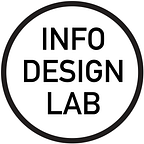Teaching information design and data visualisation: a magical brief
In 2010 we established a course in Information Design and Data Visualisation at Central St Martins in London. That course marked the beginning of a wonderful teaching journey in universities and organisations around the world, offering hands-on experiences aimed at students, scientists and professionals working in environments that require presenting information in effective ways in order to capture the imagination of an audience.
Fresh from a Postgraduate Certificate in Teaching in Design Higher Education, we were very conscious about the type of learning environment we wanted to create and, after many workshops, it was clear to us that kicking off any course with a data visualisation brief centred around gross domestic product, CO2 emissions or crime rate would probably paralyse many participants. The complexity of the content would easily become a barrier, making students stuck on the content rather than on the process of exploring and testing organisations that would enable them to tell a story they wanted to tell or to discover a story they needed to tell.
During the past decade we have written and worked with students on many briefs, but there is one that we have become especially attached to. The goal of that brief is to explore the organisation of a data-set and see how that can affect the stories we tell. Most importantly, the aim is to show that the number of ways in which we can organise information is not infinite, we can explore the data systematically, we can smell the data, have fun and get lost if necessary, before jumping on final solutions too fast. If Richard Saul Wurman’s thinking and LATCH come to mind, that is exactly where we try to head with the students by the end of the day.
The brief seems to allow every single participant, whether novice or experienced, to feel confident about the data-set, creating the premises for an engaging learning environment, sparking curiosity, pushing participants to fill the gaps by asking questions about the data-set, mastering the data in no time and immersing oneself in it.
What is special about the brief is the data, because the data is the group attending the course. This is how we prepare for it.
We collect data beforehand through a survey that students have to fill in by hand. We ask things such as age and country of origin, but also dreams, favourite colors, mood, favourite dishes, expectations regarding the course, a personal definition of information design or data visualisation and so on. We end up collecting a fairly big amount of quantitative and qualitative data, including richness and diversity of handwriting. Each student will receive one hand-out with the collection of answers from all the other students, as a simple Word Document. Most of the time participants mingle to gather extra data from the group.
We also collect pictures from the students beforehand and turn them into line drawings. The drawings of the group form the visual part of the data-set, allowing participants to focus on visual features if they prefer.
Having done this exercise for ten years with about 300 students, we have witnessed such a big variety of responses to the brief, and there is a pattern:
as human beings we organise things all the time and when we are asked to organise any data-sets we tend to literally jump on the task and we start organising things almost unconsciously.
That can be a problem, because when we design we can easily end up choosing the traditional ways that first occur to us, rather than stopping and exploring new stories or searching for the best organisation that proves the point we want to make.
Using a data-set that the participants can relate to so well, enables us discuss the learning outcomes in a way that engages every single participant.
The most beautiful thing, as facilitators, is to see something magical happening in the eyes of the students every time we launch the brief.
Collecting so many data from the participants, making the line drawings, packaging the hand-outs might be a lot of work, but it reminds us how important it is to inspire others by showing love and care for the content and for the data we collect.
That’s probably the baseline for every good data visualisation project.
